
Hildenbrandia rubra
Rusty Rock
10 December 2024
Tonquin Beach, Templar Channel, Vancouver Island, B.C., Canada
Tide: receding to a 3.7 foot low at 14:30 PST (measured at Tofino Tidal Station)
Weather: Overcast, wind NE 5 to 10 km/hour, no swell, sea rippled, humidity 84%, 7 ˚C.
Moon: Waxing Gibbous (73.8%, 10 days); Next phase, Full Moon, 15 December 2024 at 1:01 am PST; Previous Phase, First Quarter, 8 December 2024 at 7:26 am PST.
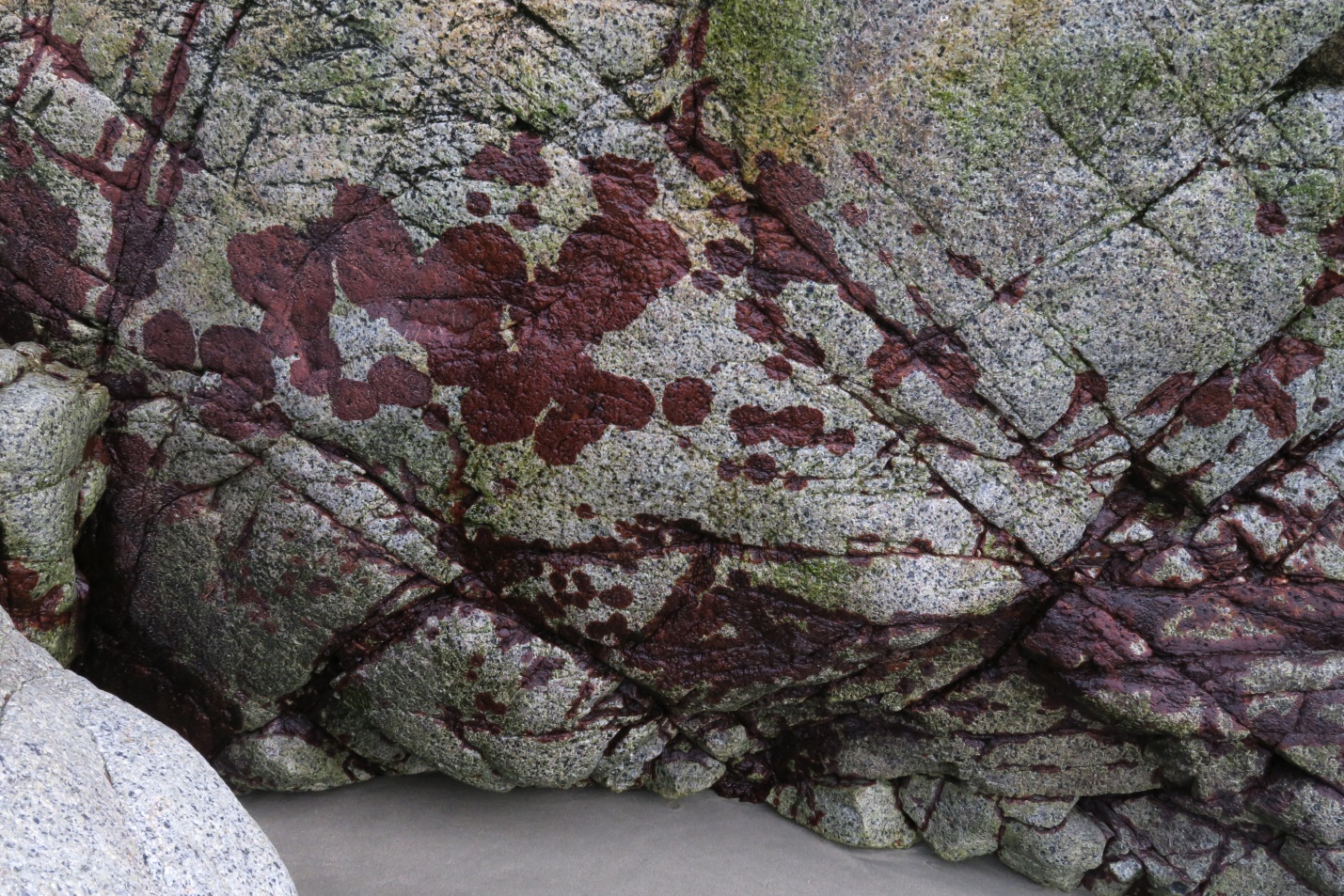
Figure 1: Granite boulders rimming part of the beach are patterned with large patches of Hildenbrandia rubra. Tolerant of the harsh marine environment that exists so high up in the intertidal zone, this seaweed is tough and enduring. Tonquin Beach, Templar Channel, Vancouver Island, B.C., Canada. December 10, 2024. Photo ID 27749 ©Seaweedwhisperings.com
Person 1:
Rather ubiquitous.
I see this alga frequently, but usually just want to walk past it, or step over it without interacting. At times I think I may even want to avoid it. Never has there seemed to be a good time to get to know Hildenbrandia rubra.
However, today, it won’t let me get away without interacting. It’s everywhere in the high intertidal, sometimes reaching high above the high water mark into the splash zone.
When wet, it is rather beautiful – shiny, smooth and exhibiting the broad spectrum of red coloration. When dry, it’s not so spectacular, appearing more like splotches of dried blood adhering to the rock.
Unlike most marine algae, this one does well in low salinity areas, and actually thrives in brackish streams and on steep bare slopes with forest runoff seepage.
H. rubra doesn’t need to struggle to survive. Rather, it opportunistically grabs homes where no one else wants to grow. Where it might have competition, it can simply go beneath and live in shallow tidepools or rock cracks where there is at least some moisture and sustenance.
Although it’s comfortable being out in the open and the centre of attention, it is equally at home out of the limelight.
I get a sense that it can be quite sneaky, at times taking advantage of shelter that others can provide, or slithering along a rock crack, barely detectable.
I think it could be quite annoying to others, especially if it intrudes into others’ space.
It grows slowly, and perhaps can insidiously encroach and overwhelm. Its spread can be in any direction..., up, down, across, over, in sunshine, in dark, on steep slopes or flat surfaces. No substrate is too big a challenge to conquer.
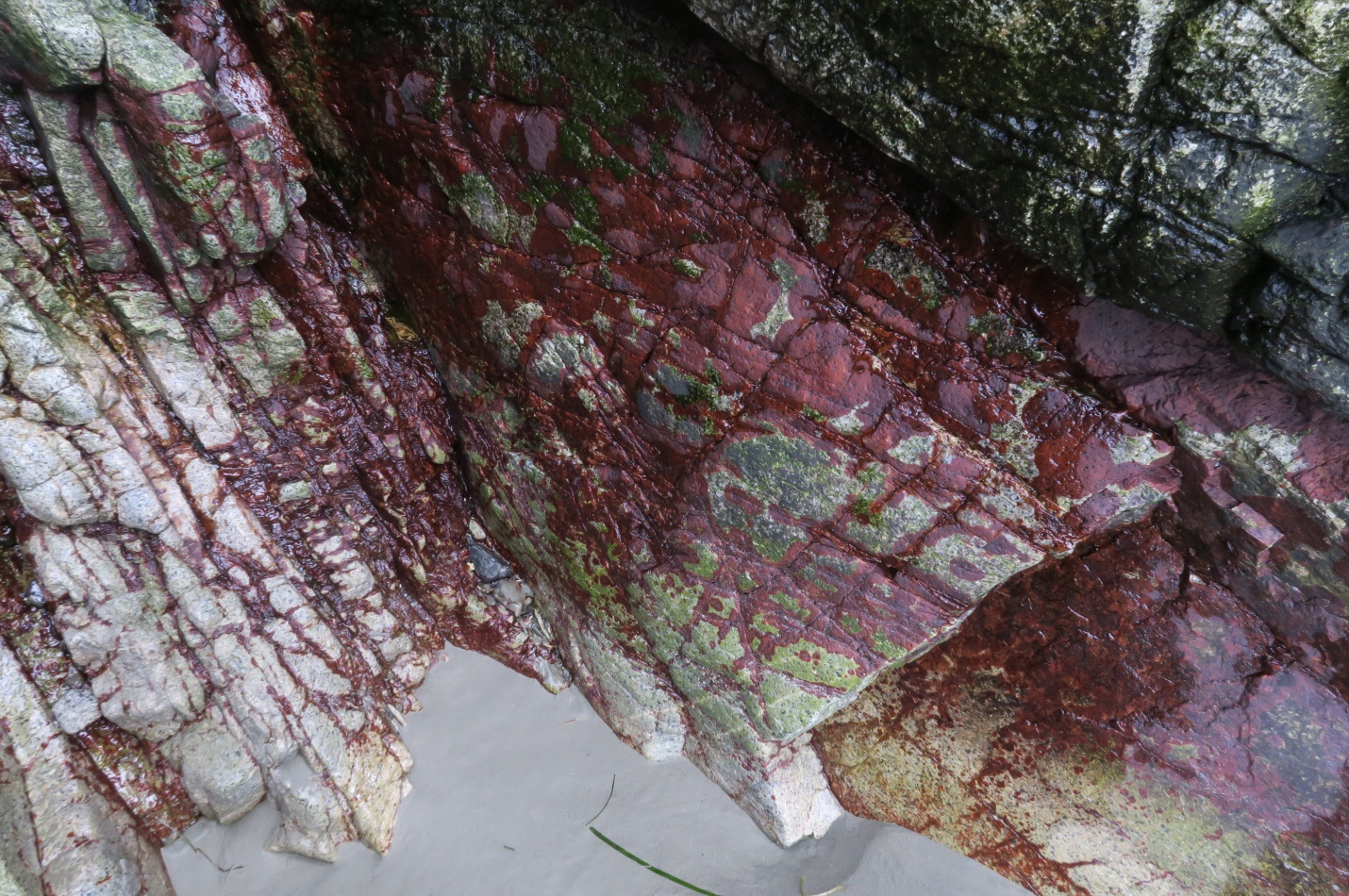
Figure 2: Another section of rock that is home to Hildenbrandia rubra. Just above it on this rock some of the ubiquitous black seaside lichen is also thriving. Tonquin Beach, Templar Channel, Vancouver Island, B.C., Canada. December 10, 2024. Photo ID 27750 ©Seaweedwhisperings.com
Person 2:
On these granite rocks that rim Tonquin Beach there is much Hildenbrandia rubra. And on this day it is strikingly red – it stands out. One could think, “What happened here?”
There are splotches of red and there are lines of red oozing out of the cracks in the rocks like a cut that has not yet sealed and still bleeds.
This strange seaweed is a thin crust and certainly doesn’t seem like a ‘weed’ of any kind most people know. It grows tightly adhered to rock, even quite distant or high up from the tide line and from where the ocean meets the shore, and can tolerate freshwater seeps. It seems as if it prefers to get a hold in the cracks of rocks and then spreads out, creeping ever so slowly and steadily, to paint more of the rock with its red cells.
“Paint” is not actually the correct word; this Hildenbrandia is thin enough that you can glean some of the characteristics of the rock beneath it, so it would be better to call it a stain (penetrative dye or chemical) rather than paint. Or certainly it is a watercolor and not oil or acrylic. And like stain differs from paint, this seaweed seems to almost ‘merge with’ or penetrate the rock it lives on.
It is like a birthmark or a port wine stain. It really doesn’t seem possible to remove it once it is there. This crust is not one that you can scratch off; it seems you’d have to grind away some of the rock if you were intent on removing it.
It is also a crust that does not seem to have any texture to it. It has negligible height (measurable to the human eye) but can form some sizeable patches. I don’t know its exact dimensions but it looks very thin and yet somehow it is also quite tightly co-joined – neighboring cell to neighboring cell, as it spreads horizontally.
This is interesting, it seems to need to hold tightly to the rock it grows on and I feel like it needs to hold tightly to its own neighboring cells, too. I wonder how it accomplishes this. What kind of “holdfast” does this little seaweed use? Does it have teeny toes that form its haptera? Some kind of suction cup action? How would it cling so firmly to rock? It seems to be really quite an accomplishment, because once in place, this persistent little seaweed cannot be budged, not one millimeter!!
If one was to be imaginative you could say that the splash of red rock is like a fresh crime scene with murder or some grievous wounding having occurred there just recently. But, the stain is not wet. And it will not wash off. I don’t think the ‘stain of red’ arrives with any speed at all, but builds very slowly in size. To come across large patches such as the ones at Tonquin Beach today feels as if this must be an “old growth” sample of Hildenbrandia rubra.
Once you begin to really look at this seaweed you tend to observe more, and more of it. It is then easy to focus on the redness and what a ‘mark’ that redness makes on rock that is usually much more sedately colored. I almost wanted to wash the red away in some places, as if it is somewhat overdone, like too much graffiti marring a lovely rock wall. I did, in some places, truly want to clear the marks away; they disturbed me.
Indeed to the human eye the red stands out, but for Hildenbrandia I have the feeling they are not even conscious of their own color. The pigments they employ comprise the necessary set for their ideal photosynthesis production.
And that is another odd thing to contemplate..., that this thin red clinging-to-rock-set-of-algal-cells is making energy from the sunlight via photosynthesis, just like other algae and land plants. There is however not a trace of anything green to this seaweed. It is red through and through.
Some of the places it grows seem to not receive much light, but others are relatively open and exposed. Some places it seems like there could be quite a bit of fresh water mixed with seawater, and some places it looks like it could get really rather hot while others look consistently cooled by the ocean waters. There seems to be a wide tolerance in this little seaweed, a wide tolerance of conditions where they can settle, declare themselves “at home”, and set about slowly growing.
I wonder if they are really so non-discriminating in their preferences or if they actually simply need to find some space in which to get established and continue to grow. Maybe they can’t afford to be choosy as to their home site because they need all that exposure on their top surface. The more room they have to spread, well, the more they can grow, and in the busy intertidal zone, most of the real estate is highly sought and competed for. So, little Hildenbrandia perhaps learned it could settle the regions most other marine algae would never deem habitable. This would certainly give them the space they need.
This seaweed seems to me to have the smallest expression of ‘movement’ of most any other one I’ve considered. The only way it seems to be able to move is to grow in width and this growth is something you’d have to wait around for a long time to visibly observe. It doesn’t seem to grow appreciably thicker. It clearly doesn’t seem to have any parts that waft in the ocean - there’s certainly no stipe or foliose blades or floats. It is a seaweed that moves only by affixing itself to rock and slowly spreading. This is a distinct and rather limited type of movement indeed.
Perhaps they don’t want to move. Perhaps they love to be “at home”. Perhaps movement is something almost outside of their imagination and desires. What an interesting way to be.
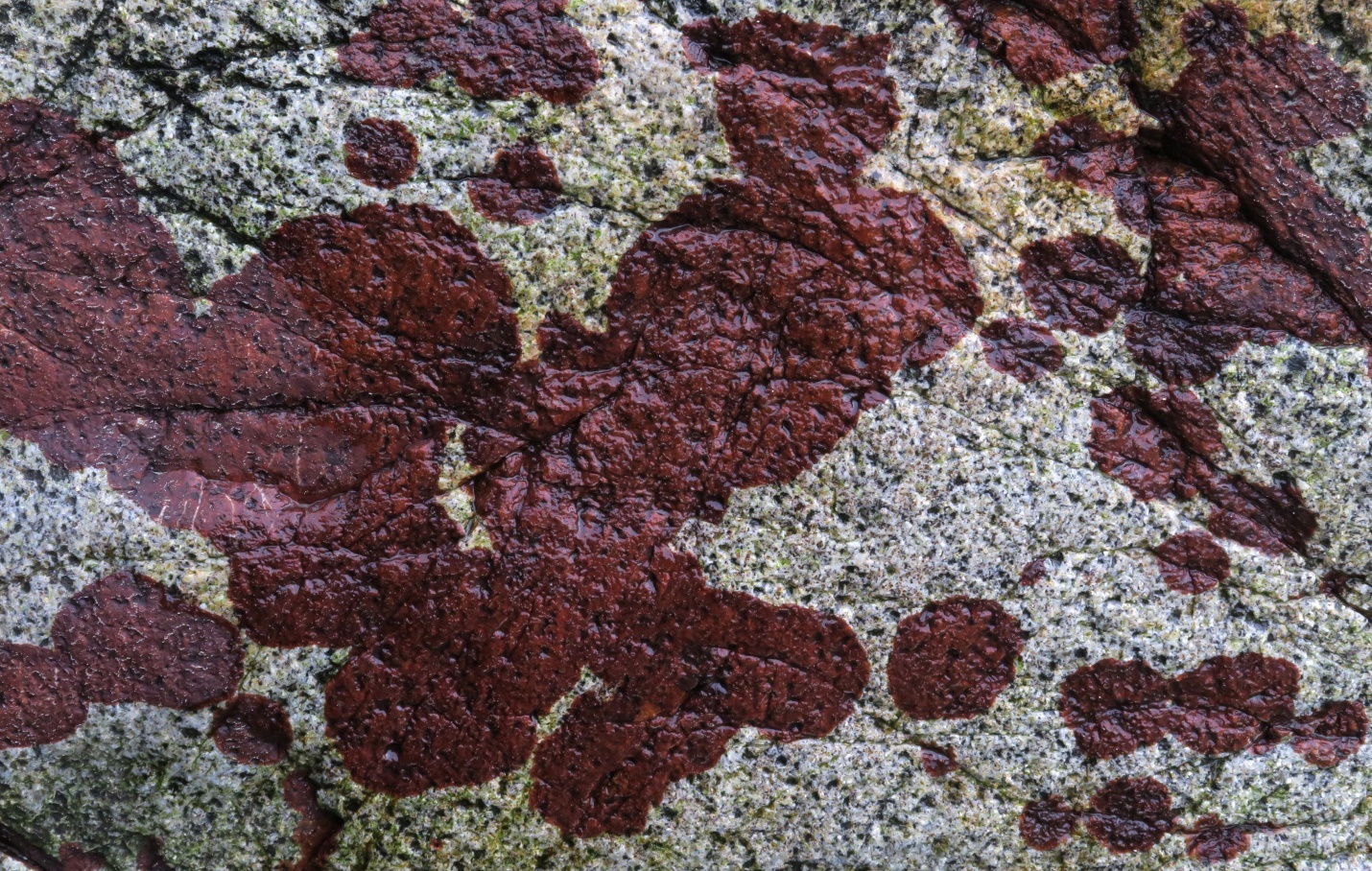
Figure 3: A closer view here shows the partially transparent look of this thin algal crust. Tonquin Beach, Templar Channel, Vancouver Island, B.C., Canada. December 10, 2024. Photo ID 27751 ©Seaweedwhisperings.com
Discussion:
Once there, it stays. Like a permanent stain! Or a permanent presence.
A birthmark – is often an unwanted permanent stain. This seaweed doesn’t have the feeling that it is wanted, in a group, community, etc. They’re quite aware of that until they can settle. Once settled, they remain. A desire to leave seems that it would be incredibly rare, as this would bring them back to the “unwanted here” situation.
They can move, slowly and steadily, but they also never really leave. Instead, they expand themselves where they exist. They also have no NEED to leave – because they are so very tolerant of stresses and a really wide range of life conditions. Even when living with extreme physical discomfort or low nourishment, they simply endure and remain.
Their wide tolerance of environmental conditions means they can thrive where others would really struggle. Maybe they are slow to grow, sometimes even surviving in states of suspended animation, but they are surviving. And they persist. They have mastered life skills that few others even attempt, and that still others would overlook – they are truly notable in their own way.
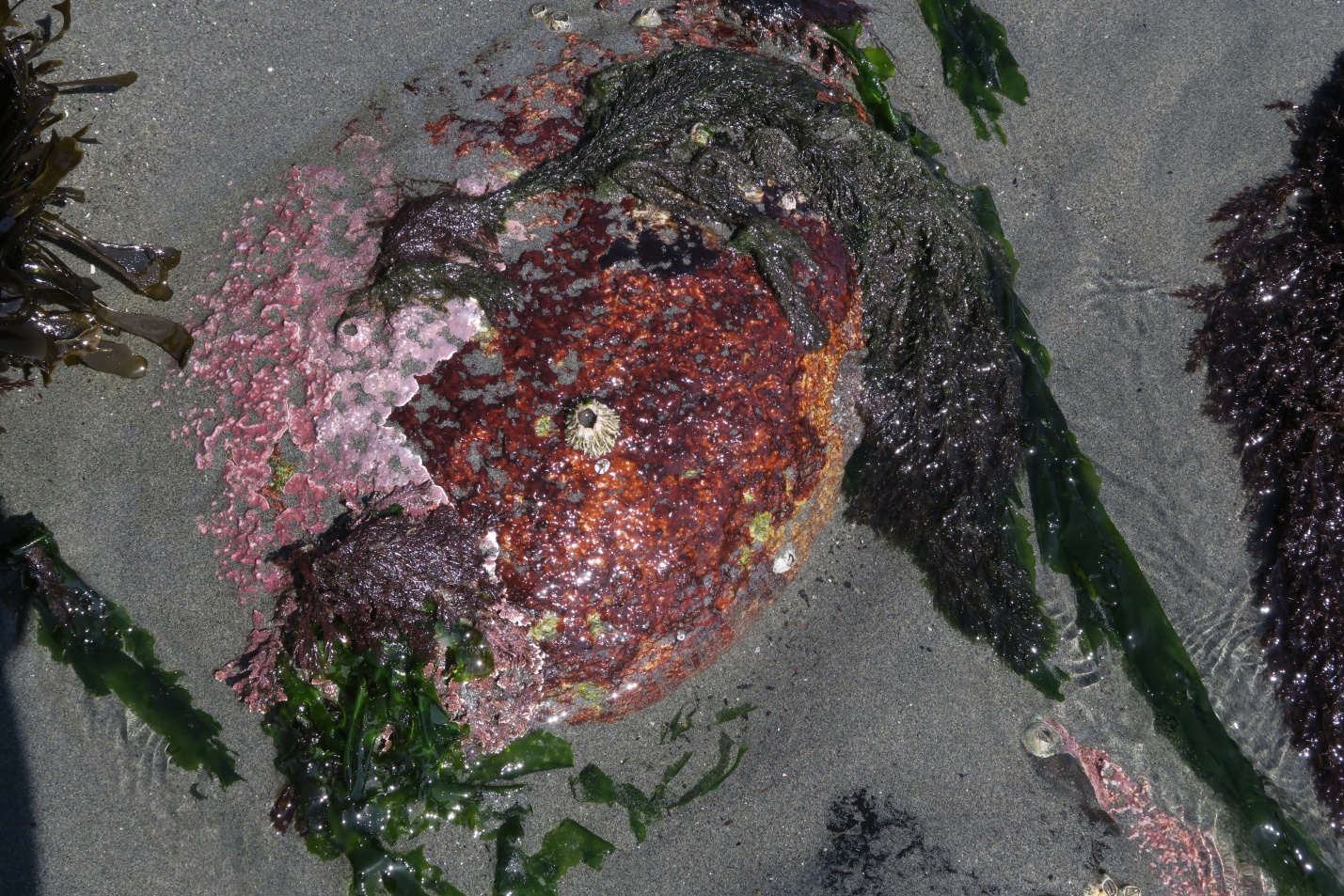
Figure 4: This large watermelon-sized cobble that is partially buried in sand is located at the low/mid intertidal zone. It is home to a few algal crusts including the pink coralline, the dark blackish Mastocarpus and the bright red Hildenbrandia. There is clearly some competition for space; some crusts are overgrowing others, and sea animals and foliose seaweeds obscure light – sometimes for considerable periods of time. Hildenbrandia rubra is tolerant of all of this – it simply slows its metabolism and persists, unharmed and showing no visible stress such as bleaching. Fishboat Bay, Juan de Fuca Strait, Vancouver Island, B.C., Canada. May 15, 2021. Photo ID 27752 ©Seaweedwhisperings.com
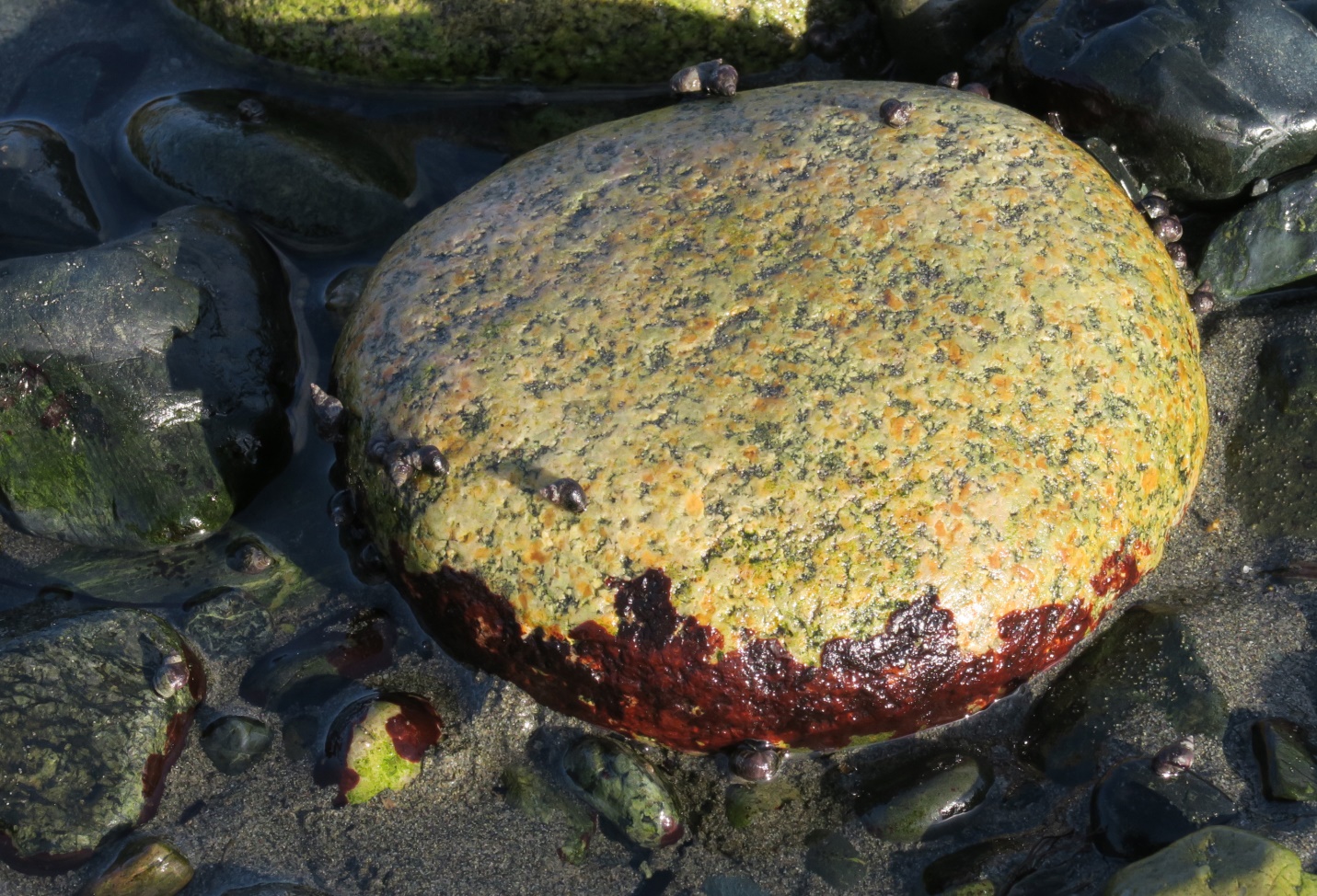
Figure 5: This closer view shows Hildenbrandia rubra on several of the pebbles. This red crust can grow on most any rock if there is space for it to move in, and it can live from sea caves and high intertidal areas right down to the more crowded intertidal and subtidal regions. Jordon River, Juan de Fuca Strait, Vancouver Island, B.C., Canada. December 23, 2023. Photo ID 27753 ©Seaweedwhisperings.com
Biology & Natural History Information:
Description:
Thallus is a rose-red or brownish-red, un-calcified crust with irregular outlines that adheres tightly to rock. Very thin, 0.2 to 0.5 mm thick, and without surface markings, the crusts can appear partly transparent. Grows very slowly to an indefinite extent. Closely adherent to substrate without rhizoids.
H. rubra is one of the thinnest algal crusts and contains no non-photosynthetic cells. There is no specialized section of the thallus of the crust devoted to adhering to the rock paired with an upper perithallus of vertical filaments as seen in other algal crust species. With H. rubra the entire crust is composed of pseudoparenchmyic cells – these are compactly interwoven short-celled filaments.
Also unlike other encrusting marine algae, Hildenbrandia is NOT an alternate life cycle stage of an erect / foliose algae. It is isomorphic, cycling from crust to crust. No sexual reproduction has been documented in the genus; the only form of propagation is via tetraspores. Tetrasporangia are irregularly divided and occur in conceptacles; this differentiates H. rubra from Hildenbrandia occidentalis as the latter has regularly zonately divided tetrasporangia.
Habitat:
Found on emergent rocks and stones and in tide pools, throughout the year, at all tidal levels; often in the splash zone, in sea caves and also sub-tidally. Widely distributed and commonly encountered particularly on the upper shore where it appears to be very tolerant to extremes of temperature, light and salinity. Hildenbrandia rubra is the only red crust that grows on rock in the upper half of the shore.
Distribution:
Both coasts of North America, from Alaska down to Panama, and from New Brunswick down to the Caribbean and other Atlantic Islands. Also both coats of South America, Russia, all over European shores, both coasts of Africa, on islands in the Indian Ocean, along the east coast of Asia, Australia and many Pacific Islands. This remarkably large range may be attributable either to vague taxonomic divisions, or to Hildenbrandia rubra’s very flexible ecology.
Remarks:
The crusts of H. rubra can be found on rocks of all shapes and sizes and in all tidal zones. Where Hildenbrandia stands out the most are regions that are physically highly stressful; its tolerance to harsh environmental conditions often means it can be found where few other marine algae are found and also where a few hardy freshwater species live. With several distinctive factors to H. rubra, one author encourages readers to “ponder the ecological significance of the slowest, lowest and lowliest group of algae”. Is it humble? Possibly, but our impression is that it finds no strong benefit to attracting attention and for its own best purposes probably prefers the absence of it.
H. rubra has very small cells meaning there is a high proportion of cell wall material per mass and also cells are interconnected via secondary pit connections; both features make it very tough and therefore difficult for grazers or other disturbances to remove Hildenbrandia from the substrate. The most conspicuous grazers of Hildenbrandia are limpets and littorine snails.
Growth is slow; lateral growth rate is often less than 1 mm per year. If this seaweed becomes worn down by grazing, Hildenbrandia’s cells will regenerate fairly quickly, and vertical growth is documented to be faster than lateral. The ability to resist disturbance and regenerate well, combined with the high environmental stress tolerance, means it is unlikely that a Hildenbrandia individual will ever be removed completely from the rock it is growing on.
Hildenbrandia, having only a crust morphology, often needs to be able to survive (sometimes for long periods of time) underneath other things including sea animals, the thalli or even holdfasts of other seaweeds, and also rocks and cobbles moved or displaced by ocean swells. This species capacity to survive such overgrowth or light obstructing presences with no pigment loss or other signs of stress appears to be an example of anabiosis – a temporary state of suspended animation or greatly reduced metabolism. Other crust species survive overgrowth via pit connections that serve as conduits for resources or hormones – Hildenbrandia does not employ this strategy.
Classification:
Phylum: Rhodophyta
Subphylum: Eurhodophytina
Class: Florideophyceae
Subclass: Hildenbrandiophycidae
Order: Hildenbrandiales
Family: Hildenbrandiacea
Genus: Hildenbrandia
Species: Hildenbrandia rubra (Sommerfelt) Meneghini 1841
Former name(s):
Homotypic synonym; Verrucaria rubra Sommerfelt 1826. Heterotypic synonyms are numerous and include Hildenbrandia prototypus, H. nardiana and H. rosea, to name a few.
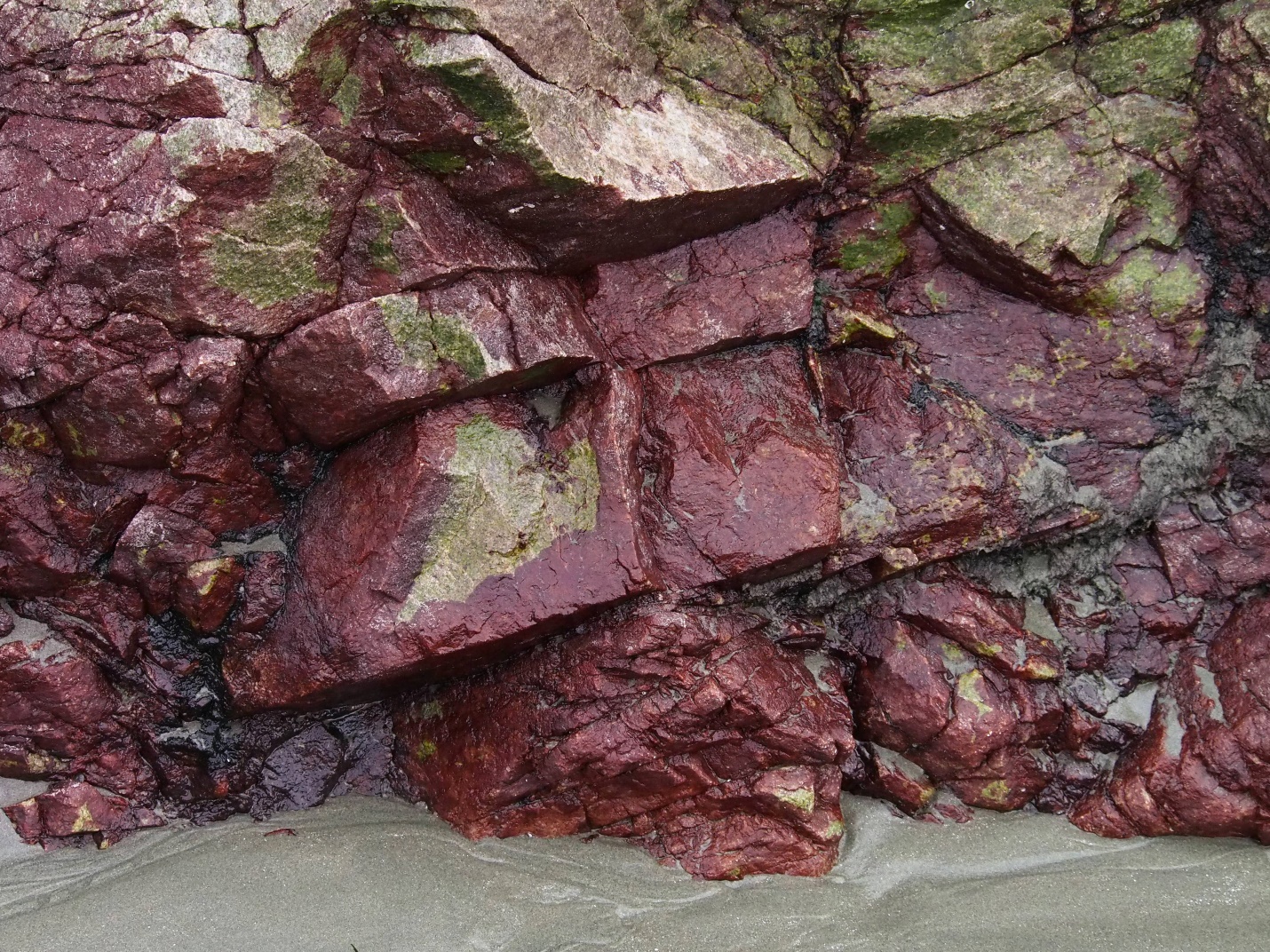
Figure 6: With a lateral growth rate of 1 millimeter per year, this large patch of Hildenbrandia rubra is indeed “old growth”. The largest chunk of rock in the middle of the picture is over one meter in length. Tonquin Beach, Templar Channel, Vancouver Island, B.C., Canada. December 10, 2024. Photo ID 27754 ©Seaweedwhisperings.com
![]()